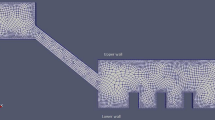Abstract
To mitigate potential damage from debris flows, numerous check dams have been constructed in thousands of debris flow gullies all over the world. However, the efficiencies of these check dams are largely unknown because they are normally designed based on empirical methods. This paper presents an assessment of the impeding effect of check dams constructed in the Hongchun debris flow gully in Sichuan Province, China by using an improved finite difference model. Compared with other models, the improved model can consider both the impeding effect of check dams and bed entrainment. We analyzed the impeding effect of these check dams on different initial scales of debris flows. The results show that these check dams perform quite well in constraining bed entrainment downstream of the gully. The average velocity, peak discharge, and final scale of a debris flow in the gully can be substantially reduced by constructed check dams. The impeding effect is sufficient when the initial volume of the debris flow is less than 1.5 times that of the catastrophic debris flow event that occurred in this gully on 14 August 2010. This study improves our understanding of the influence of check dams on the dynamic and bed entrainment processes of debris flows. The model adopted in this study can be a robust tool to quantify the efficiencies of existing check dams and provide reasonable guidance in the design of check dams in debris flow gullies.










Similar content being viewed by others
References
Berger C, McArdell BW, Schlunegger F (2011) Direct measurement of channel erosion by debris flows, Illgraben, Switzerland. J Geophys Res Earth Surf 116(F1)
Berti M, Simoni A (2005) Experimental evidences and numerical modelling of debris flow initiated by channel runoff. Landslides 2(3):171–182
Berti M, Simoni A (2014) DFLOWZ: a free program to evaluate the area potentially inundated by a debris flow. Comput Geosci 67:14–23
Berti M, Genevois R, LaHusen R, Simoni A, Tecca PR (2000) Debris flow monitoring in the Acquabona watershed on the Dolomites (Italian alps). Phys Chem Earth B Hydrol Oceans Atmos 25(9):707–715
Breien H, De Blasio FV, Elverhøi A, Høeg K (2008) Erosion and morphology of a debris flow caused by a glacial lake outburst flood, Western Norway. Landslides 5(3):271–280
Chen X, Cui P, You Y, Chen J, Li D (2015) Engineering measures for debris flow hazard mitigation in the Wenchuan earthquake area. Eng Geol 194:73–85
Choi CE, Ng CWW, Law RPH, Song D, Kwan JSH, Ho KKS (2014) Computational investigation of baffle configuration on impedance of channelized debris flow. Can Geotech J 52(2):182–197
Cui P, Chen X-Q, Zhu Y-Y, Su F-H, Wei F-Q, Han Y-S, Liu H-J, Zhuang J-Q (2011) The Wenchuan earthquake (may 12, 2008), Sichuan Province, China, and resulting geohazards. Nat Hazards 56(1):19–36
Cui P, Guo X, Yan Y, Li Y, Ge Y (2018) Real-time observation of an active debris flow watershed in the Wenchuan earthquake area. Geomorphology 321:153–166
Cuomo S, Moretti S, Aversa S (2019) Effects of artificial barriers on the propagation of debris avalanches. Landslides 16(6):1077–1087
Dai Z, Huang Y, Cheng H, Xu Q (2017) SPH model for fluid–structure interaction and its application to debris flow impact estimation. Landslides 14(3):917–928
Fan X, Scaringi G, Korup O, West AJ, van Westen CJ, Tanyas H, Hovius N, Hales TC, Jibson RW, Allstadt KE, Zhang L, Evans SG, Xu C, Li G, Pei X, Xu Q, Huang R (2019) Earthquake-induced chains of geologic hazards: patterns, mechanisms, and impacts. Rev Geophys 57(2):421–503
Gan J, Sun H, Huang R, Tan Y, Fang C, Li Q, Xu X (2012) Study on mechanism of formation and river blocking of Hongchungou giant debris flow at Yingxiu of Wenchuan County. J Catastrophol 27(1):5–9 (in Chinese)
García-Martínez R, López JL (2005) Debris flows of December 1999 in Venezuela. In: Debris-flow hazards and related phenomena. Springer, Berlin, pp 519–538
Guthrie RH, Friele P, Allstadt K, Roberts N, Evans SG, Delaney KB, Roche D, Clague JJ, Jakob M (2012) The 6 August 2010 Mount Meager rock slide-debris flow, Coast Mountains, British Columbia: characteristics, dynamics, and implications for hazard and risk assessment. Nat Hazards Earth Syst Sci 12(5):1277–1294
Heß J, Tai Y-C, Wang Y (2019) Debris flows with pore pressure and intergranular friction on rugged topography. Comput Fluids 190:139–155
Huang Y, Cheng H, Dai Z, Xu Q, Liu F, Sawada K, Moriguchi S, Yashima A (2015) SPH-based numerical simulation of catastrophic debris flows after the 2008 Wenchuan earthquake. Bull Eng Geol Environ 74(4):1137–1151
Hungr O, McDougall S (2009) Two numerical models for landslide dynamic analysis. Comput Geosci 35(5):978–992
Hungr O, McDougall S, Bovis M (2005) Entrainment of material by debris flows. In: Jakob M, Hungr O (eds) Debris-flow hazards and related phenomena. Springer, Berlin, pp 135–158
Hungr O, Leroueil S, Picarelli L (2014) The Varnes classification of landslide types, an update. Landslides 11(2):167–194
Ikeya H (1989) Debris flow and its countermeasures in Japan. Bulletin of the International Association of Engineering Geology - Bulletin de l'Association Internationale de Géologie de l'Ingénieur 40(1):15–33
Iverson RM (1997) The physics of debris flows. Rev Geophys 35(3):245–296
Iverson RM, Ouyang C (2015) Entrainment of bed material by earth-surface mass flows: review and reformulation of depth-integrated theory. Rev Geophys 53(1):27–58
Iverson RM, Reid ME, LaHusen RG (1997) Debris-flow mobilization from landslides. Annu Rev Earth Planet Sci 25(1):85–138
Iverson RM, Logan M, LaHusen RG, Berti M (2010a) The perfect debris flow? Aggregated results from 28 large-scale experiments. J Geophys Res Earth Surf 115(F3)
Iverson RM, Reid ME, Logan M, LaHusen RG, Godt JW, Griswold JP (2010b) Positive feedback and momentum growth during debris-flow entrainment of wet bed sediment. Nat Geosci 4:116
Kattel P, Kafle J, Fischer J-T, Mergili M, Tuladhar BM, Pudasaini SP (2018) Interaction of two-phase debris flow with obstacles. Eng Geol 242:197–217
Koo RCH, Kwan JSH, Lam C, Goodwin GR, Choi CE, Ng CWW, Yiu J, Ho KKS, Pun WK (2017a) Back-analysis of geophysical flows using three-dimensional runout model. Can Geotech J 55(8):1081–1094
Koo RCH, Kwan JSH, Ng CWW, Lam C, Choi CE, Song D, Pun WK (2017b) Velocity attenuation of debris flows and a new momentum-based load model for rigid barriers. Landslides 14(2):617–629
Kwan JSH, Sun HW (2006) An improved landslide mobility model. Can Geotech J 43(5):531–539
Kwan JSH, Koo RCH, Ng CWW (2015) Landslide mobility analysis for design of multiple debris-resisting barriers. Can Geotech J 52(9):1345–1359
Kwan JSH, Sze EHY, Lam C (2018) Finite element analysis for rockfall and debris flow mitigation works. Can Geotech J:1–26
Li D, Xu X, Hao H (2012) Formation conditions and the movement characteristics of "8.14" giant debris flow in Yingxiu town, Wenchuan County, Sichuan Province. Chinese J Geol Hazard Control 23(3):32–38 (in Chinese)
Liu J, Nakatani K, Mizuyama T (2013) Effect assessment of debris flow mitigation works based on numerical simulation by using Kanako 2D. Landslides 10(2):161–173
McDougall S, Hungr O (2005) Dynamic modelling of entrainment in rapid landslides. Can Geotech J 42(5):1437–1448
Mergili M, Fischer JT, Krenn J, Pudasaini SP (2017) R.avaflow v1, an advanced open-source computational framework for the propagation and interaction of two-phase mass flows. Geosci Model Dev 10(2):553–569
Mizuyama T (2008) Structural countermeasures for debris flow disasters. Int J Erosion Control Eng 1(2):38–43
Nakatani K, Wada T, Satofuka Y, Mizuyama T (2008) Development of “Kanako 2D (Ver.2.00),” a user-friendly one- and two-dimensional debris flow simulator equipped with a graphical user interface. Int J Erosion Control Eng 1(2):62–72
Ouyang C, He S, Xu Q, Luo Y, Zhang W (2013) A MacCormack-TVD finite difference method to simulate the mass flow in mountainous terrain with variable computational domain. Comput Geosci 52:1–10
Ouyang C, He S, Tang C (2015) Numerical analysis of dynamics of debris flow over erodible beds in Wenchuan earthquake-induced area. Eng Geol 194:62–72
Ouyang C, Zhao W, He S, Wang D, Zhou S, An H, Wang Z, Cheng D (2017) Numerical modeling and dynamic analysis of the 2017 Xinmo landslide in Maoxian County, China. J Mt Sci 14(9):1701–1711
Ouyang C, An H, Zhou S, Wang Z, Su P, Wang D, Cheng D, She J (2019) Insights from the failure and dynamic characteristics of two sequential landslides at Baige village along the Jinsha River, China. Landslides 16(7):1397–1414
Pastor M, Haddad B, Sorbino G, Cuomo S, Drempetic V (2009) A depth-integrated, coupled SPH model for flow-like landslides and related phenomena. Int J Numer Anal Methods Geomech 33(2):143–172
Pirulli M, Pastor M (2012) Numerical study on the entrainment of bed material into rapid landslides. Géotechnique 62(11):959–972
Sassa K, Nagai O, Solidum R, Yamazaki Y, Ohta H (2010) An integrated model simulating the initiation and motion of earthquake and rain induced rapid landslides and its application to the 2006 Leyte landslide. Landslides 7(3):219–236
Shen W, Li T, Li P, Guo J (2018) A modified finite difference model for the modeling of flowslides. Landslides 15(8):1577–1593
Shen W, Li T, Li P, Berti M, Shen Y, Guo J (2019a) A two-layer numerical model for simulating the frontal plowing phenomenon of flow-like landslides. Eng Geol 259:105168
Shen W, Li T, Li P, Shen Y, Lei Y, Guo J (2019b) The influence of the bed entrainment-induced rheology and topography changes on the propagation of flow-like landslides: a numerical investigation. Bull Eng Geol Environ 78(7):4771–4785
Shen W, Wang D, Qu H, Li T (2019c) The effect of check dams on the dynamic and bed entrainment processes of debris flows. Landslides 16(11):2201–2217
Sidle RC, Chigira M (2004) Landslides and debris flows strike Kyushu, Japan. EOS Trans Am Geophys Union 85(15):145–151
Tai Y-C, Heß J, Wang Y (2019) Modeling two-phase debris flows with grain-fluid separation over rugged topography: application to the 2009 Hsiaolin event, Taiwan. J Geophys Res Earth Surf 124(2):305–333
Takahashi T, Das DK (2014) Debris flow: mechanics, prediction and countermeasures. CRC press
Tang C, Rengers N, van Asch TWJ, Yang YH, Wang GF (2011a) Triggering conditions and depositional characteristics of a disastrous debris flow event in Zhouqu city, Gansu Province, northwestern China. Nat Hazards Earth Syst Sci 11(11):2903–2912
Tang C, Zhu J, Ding J, Cui XF, Chen L, Zhang JS (2011b) Catastrophic debris flows triggered by a 14 August 2010 rainfall at the epicenter of the Wenchuan earthquake. Landslides 8(4):485–497
Wang D, Chen Z, He S, Liu Y, Tang H (2018) Measuring and estimating the impact pressure of debris flows on bridge piers based on large-scale laboratory experiments. Landslides 15(7):1331–1345
Wieczorek GF, Larsen MC, Eaton LS, Morgan BA, Blair JL (2001) Debris-flow and flooding hazards associated with the December 1999 storm in coastal Venezuela and strategies for mitigation. US Geological Survey. Open-File Report: 2001–144
Xiong M, Meng X, Wang S, Guo P, Li Y, Chen G, Qing F, Cui Z, Zhao Y (2016) Effectiveness of debris flow mitigation strategies in mountainous regions. Prog Phys Geogr Earth Environ 40(6):768–793
Xu Q, Zhang S, Li W, Van Asch TW (2012) The 13 August 2010 catastrophic debris flows after the 2008 Wenchuan earthquake, China. Nat Hazards Earth Syst Sci 12:201–216
Zhou GGD, Cui P, Chen HY, Zhu XH, Tang JB, Sun QC (2013) Experimental study on cascading landslide dam failures by upstream flows. Landslides 10(5):633–643
Acknowledgments
We would like to thank the anonymous referees for carefully reading the manuscript and providing constructive comments to help us improve the quality of this paper.
Funding
This research is funded by the Natural Science Foundation of China (Grant No. 41877266, 41790433), the National Key R&D Program of China (Grant No. 2017YFC1501000, 2017YFC1501302), and the China Scholarship Council (CSC) – University of Bologna Joint Scholarship (File No. 201806560011).
Author information
Authors and Affiliations
Corresponding author
Rights and permissions
About this article
Cite this article
Shen, W., Wang, D., He, S. et al. Numerical assessment of the impeding effect of check dams in the Hongchun debris flow gully, Sichuan Province, China. Bull Eng Geol Environ 79, 2833–2845 (2020). https://doi.org/10.1007/s10064-020-01755-5
Received:
Accepted:
Published:
Issue Date:
DOI: https://doi.org/10.1007/s10064-020-01755-5




